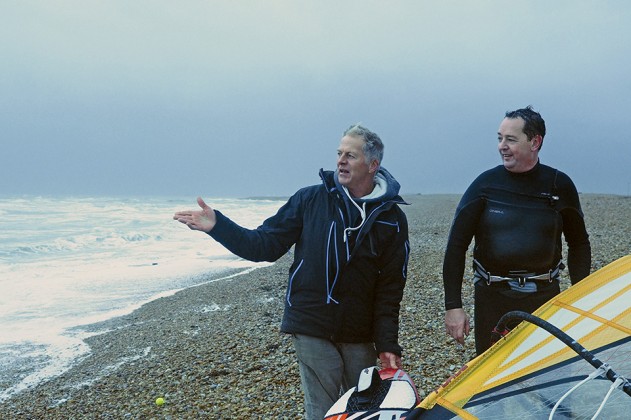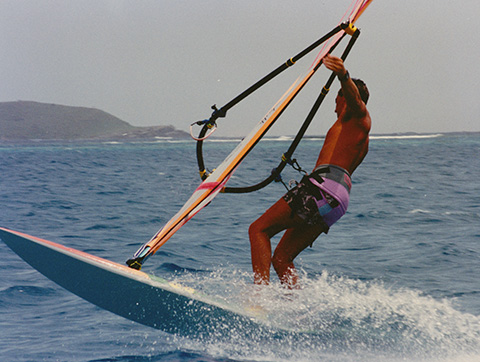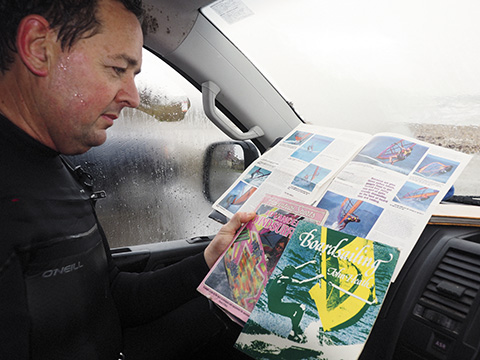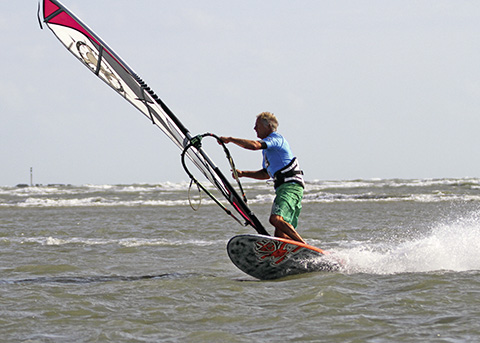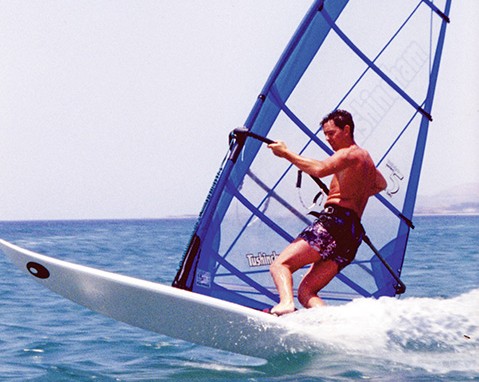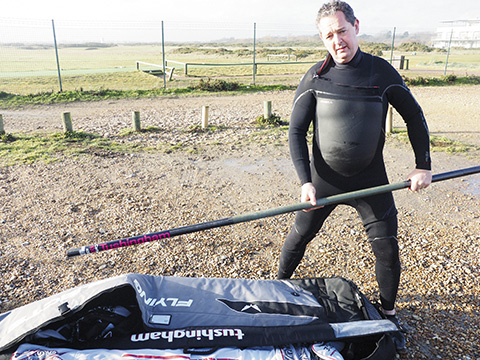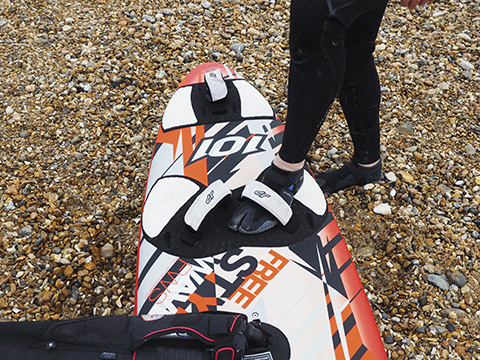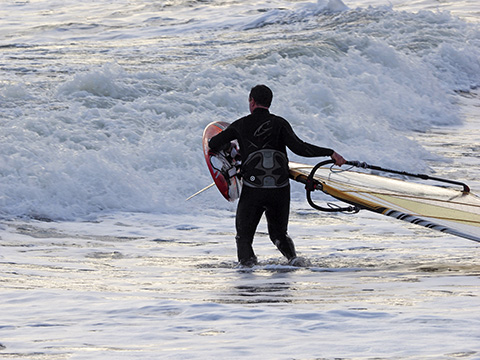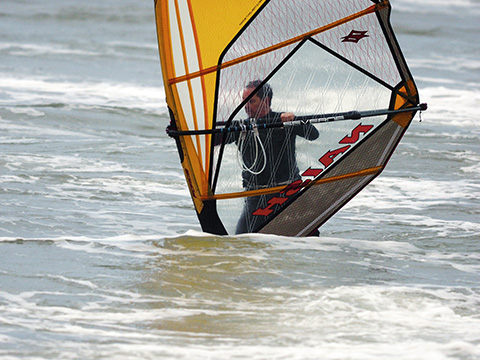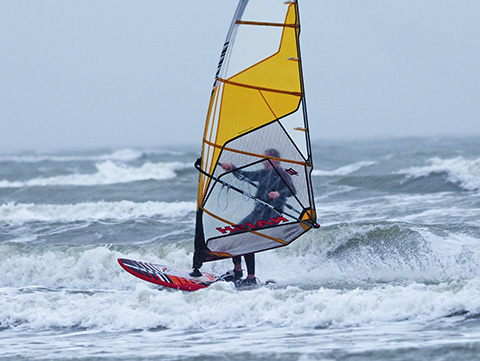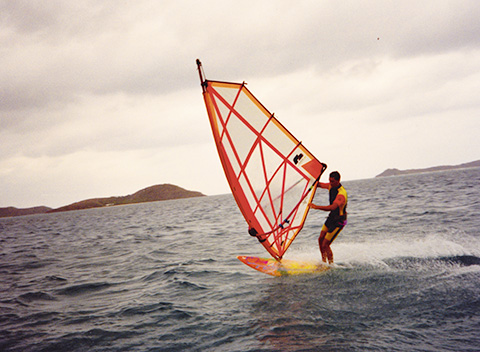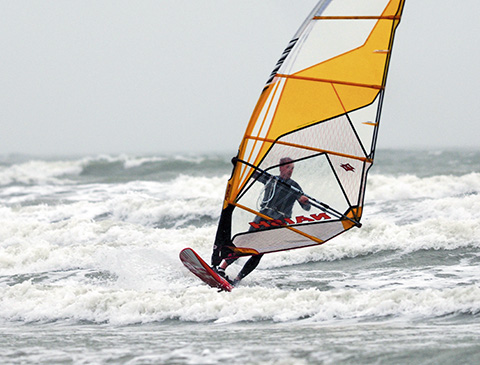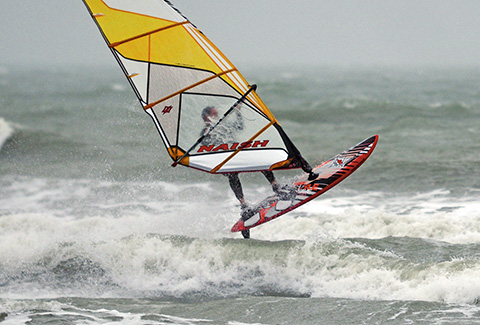A REAL WORLD JOURNEY
Words Peter Hart // Photos Hart Photography
Technique and equipment advice is all the more apposite when it’s filtered by those for whom it’s intended. Harty plots the progress and experiences of CHRIS GRAINGER – a fanatical, real world recreational windsurfer on a comeback mission.
What is the typical planning process that precedes each issue of this magazine? Perhaps you imagine a focus group of serious, grey-faced intellectual types, starved of sunlight, huddled around a desk for days on end like the desperate players in an all night poker game, thrashing out major issues such as how a certain blend of content and style might relate to a key demographic? Or do you think a chance meeting in a pub sparks an idea and 10 minutes later the team is running with it?
Well in the case of the piece that follows, it was very much the latter – except the pub was in Tenerife. But many of the best things in life are unplanned.
Chris Grainger bumped into the Windsurf test team last summer in El Medano and offered himself up as subject matter for an article. More lab rat than Narcissist, he was happy for his warts to be candidly exposed and suggested his return to windsurfing after an 8 year break could make interesting reading.
Ours is a constantly evolving sport and there’s a natural assumption that all the evolutions are ‘better.’ But better for whom? After all, it’s driven from the top. The manufacturers decide the categories and the pro team riders test tweak and approve the designs, which inevitably reflect their own desires and preferences.
Modern sailing styles, high booms (and in some cases very low booms), long lines, waist harnesses, have all filtered down from the pros and then, for better or for worse, have been adopted by the common man. If people are new to the sport, they run with it because that’s what everyone else is doing. If they’ve been in it a while, like watching their kids grow up, they absorb the changes gradually and so don’t really notice.
A GOOD CRASH TEST DUMMY
But Chris’s progress makes a good study for a couple of reasons. Having been windsurfing for 30 years, he has a wealth of experience and left the sport at the top of his old school game having nailed carves, duck gybes, tacks and 360s (and, most impressively, 20 back loops). That meant he would have the sensitivity within his limbs and digits to feel the effects of design changes and make an objective decision as to whether they were just changes for change’s sake, or if they would really help him move on. He also returned to the sport with specific and, it has to be said, pretty lofty goals, which were to learn to wave ride properly; and to enter a BWA wave contest and complete a forward loop on port tack.
The following is by no means a definitive investigation designed to expose our industry as a cosy, self-serving cartel. It’s just one of many journeys that might help answer questions like: Have we really moved on? Is the kit really any better? Do you have to completely rebuild your approach and technique to sail it?
Chris wants to reach new personal heights but much of the motivation is altruistic. To those thinking of returning, he hopes to show that the new kit HAS made it a lot easier. And by his mistakes, if he makes any, he hopes others will learn and find the least troublesome path back in.
I should point out at this stage that my role in this project has been less hands on coach and more email mentor, someone to bounce ideas off, offer general advice and answer questions like “is this feeling I’m feeling, what I’m supposed to be feeling?” It’s only in the past couple of weeks that our paths have crossed on a beach and that I’ve been able to comment directly on his sailing. For the most part, he has beaten his own path.
First question Chris – why those particular goals?
CG. When it came to wave-riding, I never really got it. I always went out in onshore conditions because that felt safest and at least I’d get washed in if it all went wrong. But my memory is just of getting dumped on by white water. I’d tolerate the waves but when it came to riding, all I’d be doing was sailing back in.
As for the forward loop …back in my era being able to bang out a planing carve gybe set you apart. Today it’s the loop. It seems to be the move you’re judged by.
// Off the tepid waters of Tortola, 90 kg Chris duck gybes his 85 ltr Alto – tricky stuff for the era. The razor rails are in full view – catch them at your peril.
A LONG HISTORY
Chris is a 49-year-old Irishman, originally from Belfast, who has windsurfed from the year dot. He cut his teeth on a borrowed Windglider, the original Olympic class for the 1984 games, a huge lump of unrefined Teutonic plastic. He was also on the Irish National youth sailing squad. By happy coincidence his coach happened to be an F2 dealer (as well as being his sister’s husband). So when he went windsurfing, Chris tagged along and got to use a Comet – by the standards of the time, a lively funboard of ‘just’ 330 cm and 170 litres. After University in Sheffield, he did seasons for Mark Warner but it was during an extended jaunt in the Virgin Islands on Tortola that he really made progress. His one board there was a Bic Alto – a 255 cm, 85 ltr wave board, pretty small given a fighting weight of 90 kg. Life then took over and before he knew it he was married and living in the Hawaii of the Home Counties – Surrey. He stopped windsurfing, partly though lack of opportunity and partly through a new found love of horses. I interrupt his flow at this point and suggest that when it comes to horses he could have saved a lot of time and hassle by getting someone to kick him relentlessly in the buttocks and then rob him. The joke wasn’t lost on him but he explained it was a pastime he could share with his partner and which turned out to be as obsessive and time-consuming as windsurfing. However, windy blood runs thick and deep and a year ago the decision was made somewhere deep in his lower intestine, to return to his first love (windsurfing that is – not a teenage raven haired colleen). And he was going to do it properly.
STEP 1 CHOOSING THE GEAR
This could be a nightmare. Like being faced with a Chinese takeaway menu, the sheer volume of choice can ruin your appetite before you’ve started. But he didn’t dither and given his desire to focus on waves, he narrowed the choice down pretty quickly.
CG. I read that to find the best all round size for waves, take your body weight and add 10 litres. So I went for a Freestyle wave 101. I couldn’t find a retail outlet which did demos so I couldn’t try before I bought. I did all my research on websites and YouTube, which confirmed my choice. Then I walked into a shop down in Poole and bought it outright. Why didn’t I buy it online? Probably because I am old and I still think that shops are the nucleus of a windsurfing community. I still love wandering around a shop soaking up the surf culture and buying into the lifestyle. Anyway, it was the easiest sale that shop owner has had in his life!
Following his one week jaunt in El Medano, where he sailed every day and tried loads of different kit, he supplemented his quiver with a 93 freestyle wave with thrusters, which has turned out to be his ‘go to’ board.
Given that his main focus was to conquer waves and wave riding, wasn’t he tempted by the dedicated wave board and a bit less volume?
CG. First up I had LOT of new things to get used to and wanted to make life easy. I needed a bit of instant gratification! I didn’t want to make the same mistake as I did before, in that my old wave boards were too low in volume.
That’s solid logic. If you’re struggling to decide between a wave and a freestyle wave, the freestyle wave is probably the right choice. As for volume – if you only have the one board you’ll always get more use out of a bigger one. When you’re constantly getting in the right place of the right wave and still feel it sticking in the face, bouncing and holding you back, that’s the time to change.
DIY LEARNING
To his credit Chris was very much a DIY man. His approach had been to stick the technique pages of Windsurf magazine in a book, take them to the beach and then read the relevant one before going out. He was now interested to see whether he could still apply the same strategy for the new journey or whether he’d need more hands on guidance.
THE JOURNEY, PART 1 – THE TRIM AND STANCE
Chris got in touch with me in July of 2014, shortly after this trip to el Medano. Being around the test team, he was made aware of a total change in wave kit culture, notably the new relationship between board and sail and a different way of trimming, carving and controlling and delivering power.
CG. All my wave sailing in the past was about getting on the smallest board possible and then making it work by always being totally powered up. The manoeuvrability came from the low volume and thin rails. I had an 85 ltr and a 90 and I’d use the 85 whenever I could – small board, big sail. But now I’ve been told big board, small sail is the way to go. Today’s bigger boards, shorter and curvier, are a lot looser and plane earlier. The guys in the test team said that using the 101, I’ll never need a sail bigger than 5.8.
That old style Chris describes is basically free-riding in the waves. Being maxed out all the time all you can do is stand between your feet, slalom style and resist the power. As a result it’s very hard to control speed in the waves. Hence you outrun them or just charge around in between them.
The modern way is to rig down. The less power you’re carrying the easier it is to depower, wash off speed and the more you can move, forward, back, to windward and leeward to trim the board and drive the rails harder.
The bigger board obviously helps early planing but how you get planing and the sailing stance is quite different.
CG. With the older stuff, I basically sailed off the leech of the sail and directed the power into the back foot and the fin, in a straight line and in carving turns. The leeches were tighter and the single wave fins were big and powerful enough to drive against. On the new kit Pete said you sail off the luff and the front foot. You don’t use the fin to get going (that’s hard to get used to). You use sail power not fin power, which means bearing away more and standing taller and more centered so you drive the board and not just the fin.
And all that can only happen from using longer lines. Chris used to be on 26” lines – standard fare for the day. Short lines make you rake the sail back and load up the tail and fin – and that can work for big sails and free-riding when you have a fin to hoof against. So Chris went longer – but didn’t go crazy.
CG. I got 30s. I know the trend for waves is even longer, 32s or even 34s but I preferred to make a gradual change. I took them off to start with. I hated them but now I love them. You just have to sail a bit differently – use the legs to push the hips back, not just sit down – but then suddenly you have all this extra room and don’t feel like you’re wearing the rig.
As for the harness – I used to use a waist harness but it always rode up and I guess that had a lot to do with the short lines. Waist harnesses have come on a lot and my new one stays put.
THE JOURNEY, PART 2 – RELEARNING TO CARVE
Chris’s trip to the test centre at El Medano, where in one week he put in 22 hours practice, was a major turning point. His fitness improved and he had the time to experiment and persevere with the new concepts.
He soon adapted and was sailing around comfortably but around the corners the new boards still felt alien. Here’s our email natter following those first sessions.
JULY 4TH CHRIS
CG. Pete, the biggest observation I have moving from an old style board to a new style board is the directional stability or lack thereof due to the shorter waterline. With the centre of effort further back, the riding stance more upright and the buoyancy underneath the feet, I feel the board is hooking the turns. They feel ‘twitchy’ and I’m inclined to over rotate. Also, with the extra volume I found the board bouncy. But I felt much happier using the smaller tri-fin – it felt so much calmer and held in through the turns.
Hi Chris
Interesting – but an understandable reaction! Your original old board was narrower and straighter and so followed a longer arc. The new one has more much more curve in the plan shape so naturally turns tighter. But if it feels twitchy, it’s because you’re turning too much off the tail. There’s so much curve in the back section that if you just engage that section of rail, it’ll try to turn inside itself. Turning more off the front foot, engaging more rail and taking the load off the fins is the way to go. You’ve paid for all of the rail so use it!
As for the role of the fins – the fins certainly influence performance and I’m glad you appreciate the feel of the thrusters. Yes they do calm the board down and make it ride a little lower – but they are just the icing on a complicated cake and the true performance comes out of that blend of plan shape and rocker line. Old boards used to trip if you engaged too much rail, so leaning forward and burying the rail right up to the nose logo contradicts your every instinct – but you have to do it – and when you do, it’s life changing (not life- ending!)
Harty in 2014 on a 103 fsw where the emphasis lies on getting the rig forward, projecting hips and body forward, softening the front knee, engaging more of the rail, turning tighter and keeping the nose down.
Classic 90s gybing style from Chris, laying the rig down and back and turning off the back foot.
GYBING PAST and PRESENT
Returning to the sport having mastered the art in the 90’s, the major changes revolve around the difference in board shape. Those early wave boards were relatively long (250 cm plus) and narrow (55 cm); and their manoeuvrability came from their low volume and their tail rocker. You turned them, therefore, mostly off the back foot. Since the early noughties, wave boards have become more and more like surfboards – shorter and curvier and designed to turn along the whole rail, not just the tail. The front straps are therefore placed further inboard and forward, so we aim to turn more off the front foot.
THE JOURNEY, PART 3 – INTO PROPER WAVES
The opportunity for practice sessions on the UK’s south coast during the recent Mediterranean summer were few and far between, so with the BWA event in Cornwall looming, on a forecast Chris took himself off for a weekend to his former home patch of Donegal and to the beach of Magheroarty .
Here was his report and my reaction.
18TH AUGUST
Peter,
I was really nervous sailing Magheroarty for the first time. Everything was different and unfamiliar. It was port tack, there was a gusty SW wind with holes close inshore and fierce gusts out in the middle of the bay. The waves were manageable, but in the middle of the bay the swell was as big as anything that I have sailed on.
It took quite some time for me to build up the courage to sail upwind to the pier break which, as you said, was much cleaner and easier to sail.
I was having a brilliant time getting more and more adventurous until I went too far into the reef to get a longer ride, and was faced with a rock sucking dry in front of me. I got caught on the last section. Big swim! I recovered, re-joined the equipment and sailed out of the situation but it really dented my confidence.
Sunday the wind was from the NW (more onshore) and I was sailing alone. That was even more disconcerting.
I kept the same 5m sail rig even though it was a little too much but it helped me punch through the onshore beach break.
I was really nervous. My sailing really suffered as a result. I made mistakes that I haven’t made for years.
So I went down to the beach break and spent short sessions getting out through the break and riding the wave all the way back to the beach. All pretty basic stuff.
By the end of the day I was comfortable again and was picking up the larger of the waves. I did get put through the rinse cycle a few times but I was happy enough to hold my breath, let it all happen and to sort myself out afterwards.
I left Magheroarty with mixed emotions.
What I had wanted to learn was port-side loops and wave riding. What I did learn was how to handle unfamiliar conditions.
I also learnt that I am not as good a sailor as I thought, or remembered I was. There is certainly no place for “ego” when the sea is involved!
Chris
Hi Chris
Welcome to proper wave sailing! That episode was a perfect wave learning experience even though it probably didn’t feel like it at the time!
Magheroarty is certainly a mistress with many moods!
In reef breaks across the world it’s ever so easy to lose orientation and nibble in a little too deep – especially if there’s a big gap between sets and you lose track of exactly where you are – but at least there’s no fire coral on those boulders!
It’s a funny thing with reef breaks – they are often SO much easier because they are cleaner and predictable; and, if you get it right, you can sail back out through the channel well away from white water. But the whole notion of having rocks underneath you makes them initially feel scarier – although often beach breaks are more violent.
Very interesting about sail choice on the NW day – being over-powered is a safety blanket but does restrict what you can do on the wave, especially going down the line.
It is all about confidence and it’s very hard to be confident when you’re out there alone! But next time, when it’s all more familiar, perhaps you’ll rig down a bit.
That whole experience is exactly what it’s about. You can’t cut loose until you’re 100% comfortable and have buried psychological demons. It’s just a fear of the unknown and when the ‘unknown’ is known (i.e. =you get trashed and survive) the monster’s teeth retract.
Keep on swimming!
Pete
Pete
You have hit the nail on the head. On Sunday morning I was on the beach looking at the wave thinking “I should be looking at those waves excited about the fun I will have with them but I am looking at them thinking that each and every one of them is out to get me.” In the afternoon I was looking at them and thinking “they are not that big really, why was I so concerned?”
Chris
THE MEET
Nine months on from when Chris contacted me, we finally met upon a windy beach and I got to see him sail. It was actually pretty miserable (the conditions, not his performance). Despite the forecast, it was bolt onshore, 18 knots max, messy waves, freezing air temp and even colder water. But on a day when most wouldn’t get out beyond the white water even if they wanted to, Chris was gybing, tacking and manufacturing the odd jump despite the hideous direction. It wasn’t a loopy day and nor were the waves good for anything apart from avoiding or getting the odd backside smack.
Apart from some old school gybing elements (strap to strap and laying the rig back and down), the rest of his game looked right up to the minute.
It’s far from over but our meet gave us a chance to discuss the journey so far.
Chris discovered that you can get away with a smaller sail these days but only if you use a bigger board and a high percentage carbon mast.
One set-up hangover from the early days was tight footstraps. Chris had opened them up to accommodate boots. But by modern wave sailing standards this is still tight. On your riding side, the toes of the front foot should be at least a couple of inches across the centreline with the strap almost resting up against the top of your ankle.
Lofty but realistic goal setting was a key factor in Chris’s success. Having the ambition to enter a BWA wave event forced him to up his game.
Weighing in currently at 100 kg (plus a bit), the 101 was still pretty small to be a ‘big board.’ Cruel though it sounds, losing weight is the fastest way to improve on all fronts.
CHRIS – THE LESSONS LEARNED TO DATE
These are my reflections on my return to windsurfing in 2014:
1. Well the sport has definitely changed and changed for the better. Time on the water is EVERYTHING as it was then, so it is now!
2. Embrace the new boards, they are brilliant. But they won’t do it all for you. Coming back to a sport you expect to be as good as you were. But you’re older, slower, perhaps heavier and definitely in denial. But be patient. The first time I got on the new kit, I thought, ‘here we go …same old, same old…’ It was only after a lot of work and making an effort to adapt that I really began to see the benefits and how much further it would be able to take me. .
Multi fins are the way forward. Despite what the shop said, I found the 101 fsw really bouncy on the wave. In my experience there is no getting away from the extra volume and windage that a bigger board brings. The thicker rails were noticeable in the bottom turn. However, with the 95 thruster most of those issues went away. The board tracked beautifully, it gripped in the turn and came out planing much more easily. I can honestly say that the only reason I would put my old board back in the water is just for nostalgia.
Go on holiday to a test centre and try as many boards as you can. I actually wish I’d done that before getting my first new board.
3. SAILS. I had been told that the sails had become lighter and more powerful. So much so that I could expect to sail in the same strength of wind with 0.5m less sail area. In my opinion that is only true with two fairly big caveats a) You buy a high percent carbon mast and b) you are sailing a higher volume board. I bought a 40% carbon mast – mistake. It’s when Peter told me to go 100% (AND get the softest recommended, a 400) that I really noticed the difference and it was huge.
4. Lose weight! When I bought my JP Freestyle 101 I weighed 105kg. This was a compromise. The extra volume did help with my extra weight but I lost all of the advantages of the new style of riding. However, after Tenerife I weighed in at 95kg and I had a Eureka moment. Less sail, more floatation equals the ability to over sheet the sail and have very little force in your hands when either wave riding or rotating. Before I was maxed out everywhere – if I overtook someone, I thought I was sailing well. But now I want to slow it down and surf.
5. Trying something new, it really works! For my first year back in the sport I set myself a very definite task of entering a wave contest. I did the Rhosneigr and Cornwall events. Competition forces you to up your game. By setting myself that goal I did some pretty amazing stuff, well amazing for me. I got through a round and had the best and most inspiring time sailing with the big boys. I have certainly improved.
As for the loop … I tried a few but I never got close. I thought the new kit would make it easy – apparently not.
7. You HAVE to push yourself – pain and gain and all that. I got genuinely scared at Magheroarty – but I survived and after, the waves at home felt small. I was at West Wittering shortly after. I flicked the board off a wave, came down on top of white water flat to the sail and was surfing in with it thinking “this is fun!” I wasn’t at all scared.
8. It’s never too late to take a lesson. Throughout my years of windsurfing I have had very little opportunity to sail with people better than me and apart from the advice Peter gave me, I have never had a windsurfing lesson. So next year I hope to attend a Peter Hart Masterclass and maybe I can shortcut the learning curve. Whatever happens, there is one thing that hasn’t changed in all of the years I have windsurfed. Windsurfing is an awesome sport that is enthralling, exciting and knows no limits. Bring on 2015.
Solid gybe, but the feet are too close together and the hips too far back.
It’s the way he used to trim his narrow tailed Bic Alto.
But the exit of the gybe was relaxed and dynamic.
That he managed to manufacture any air in the dead onshore wind was a victory.
THE MEET
After 6 months of correspondence, it was a pleasure finally to see Chris perform, albeit in grim February, onshore, cold, fluffy, mushy conditions. But the fact that he could get out and do anything was testament to his progress. After so much sailing in the 80s and 90s, certain habits will die very hard. His gybes, while consistent, still betray some old school traits. The back foot is too far forward on the rail and his hips are behind his feet. Those same habits will hinder his wave riding. He just has to project, knees, hips and upper body further forward – but he’s definitely going in the right direction.
THE COACH’S VIEW
I’d say that his approach, the choices he made and his observations are spot on … mostly…
Kit. The kit choice was good but … as we met I did ask Chris if he had one of those corrective mirrors at home that makes you look smaller than you are. Chris is a big lad. Even at his ‘best’ summer weight of 95 kg, the 101 fsw was pretty small to be his biggest board. By the time we met he’d crept back up to about 103 kg which meant that at the first hint of a lull, the 101 was some way below the surface.
He’s reluctant to go bigger, because the 101 fsw felt bouncy in the big waves of Donegal – but that was more to do with design than size.
It works in shallow mushy waves, but thanks to its speedy, straight rocker it sticks a little in a steep wave face. If he’s serious about wave riding, when the best times are often to be had in non planing winds, he needs a big wave board – and these days there are some crackers of 100 ltrs and more, which are looser and less bouncy than the old 80 ltr designs.
The problem he has right now is that with his 101 and the 5.8, he needs a good 20 knots to get him going. Losing 10 kg would immediately solve the problem. Whatever, he needs some kit to get him out there planing and training in 15-18 knots, the sort of winds that prevail around our coasts. A 118 fsw with inboard straps and a 6.8 would do the job. To get better and fitter for windsurfing, you have to go windsurfing whatever the wind.
Sails. He’s right about the power of modern sails. In truth, the sails of the 90s with their full heads and tight leeches, created more grunt per square metre. The problem was that a lot of that power was lateral drag and hence you needed long sharp edges and a big fin to resist it. Today’s wave sails work very differently. The power comes not so much from the fullness but from the leech reaction – the mast bending under load and then returning. The quicker the mast returns – i.e. the higher the carbon content – the greater the early planing power.
Fitness. He did stress the importance of losing weight and fitness but perhaps not even quite enough. To reach the level he aspires to, you have to be dynamic, reactive and explosive AND be on the right kit – if you’re carrying excess litres, square metres and fat kilos, it just doesn’t happen.
Technique. As for the technique, as he set up his board for our freezing winter session, I noted that even though he opened up his front straps to accommodate boots (which he hates), he didn’t open them up enough. His straps for boots were like I have them with bare feet. His toes were barely over the centre-line. This is key. The toes have to be right across. If the strap blocks your ankle and you can’t initiate carves off the front foot, then you will drop back and turn off the tail.
Powered up on flat water, the moves I’ve told him to work on are upwind and downwind 360s in the straps which are only possible if you depower the sail and, crucially, stand 100% on the front foot to control the nose.
Goals. The wave riding and entering a contest were the perfect goals for Chris – the forward loop, not so much because it was often an unwanted distraction that ruined his day. He told me about a great session he had on the south coast – good waves and long floaty jumps – but he left on a downer because he hadn’t gone for a loop.
Forward looping lies outside regular windsurfing technique. Of course it does demand technique but to start with the challenge is 95% psychological. I shall save the whole subject for another time but it’s primarily about creating a special environment, a mix of elements which are likely to make you snap and go for it – nice weather, competitive mates, the right board, comfortable wind, tequila – whatever. If you’re just sailing around by yourself expecting something to happen, it won’t.
And finally to those returning, the new kit IS better – look up and there is no ceiling – but it’s like a gym membership. Just going to the gym won’t get you fitter – you actually have to do something once you’re there …
Welcome back!

